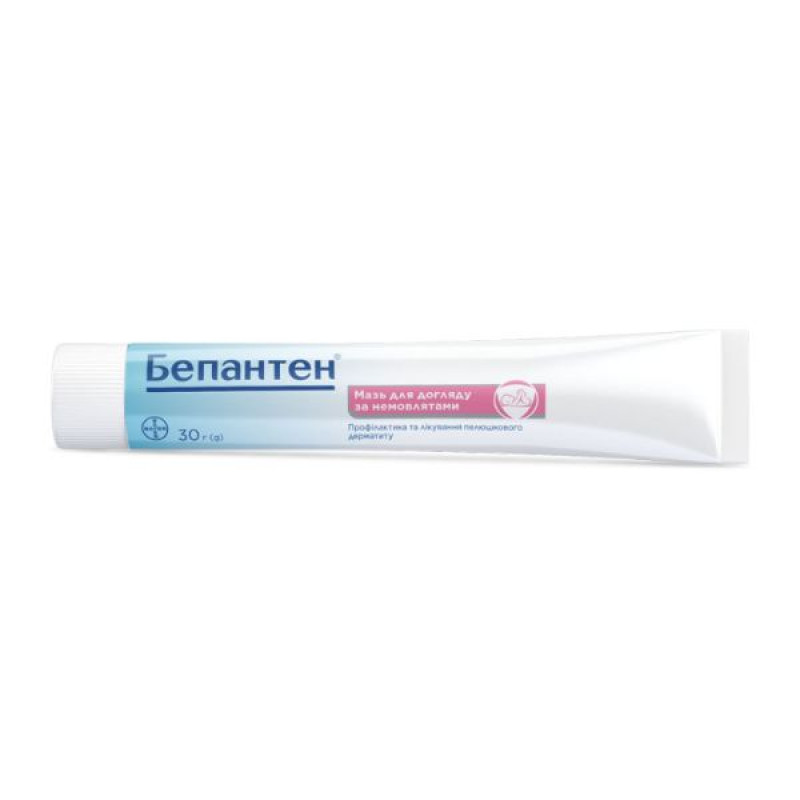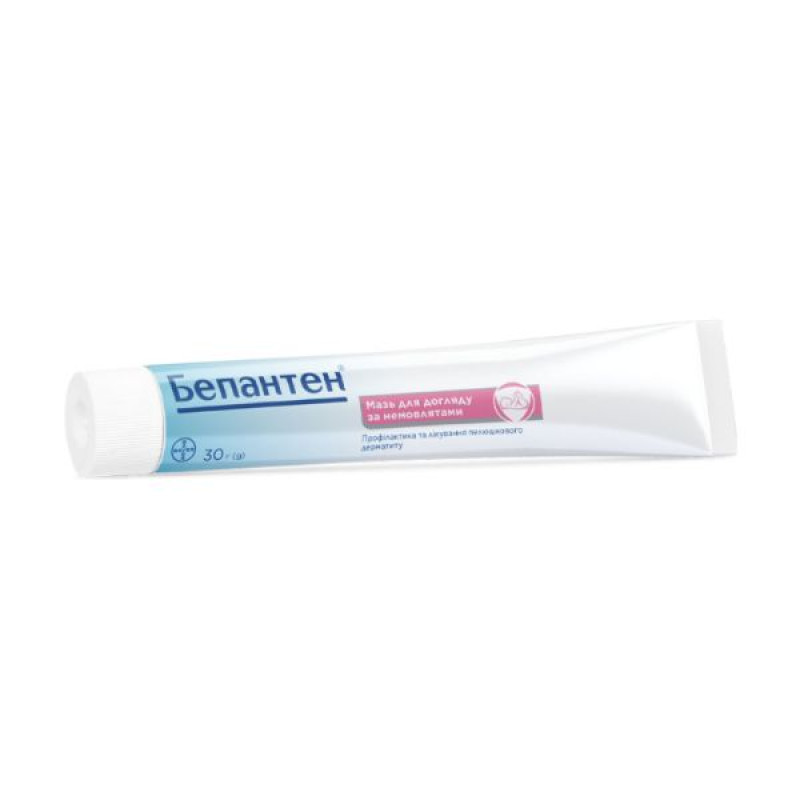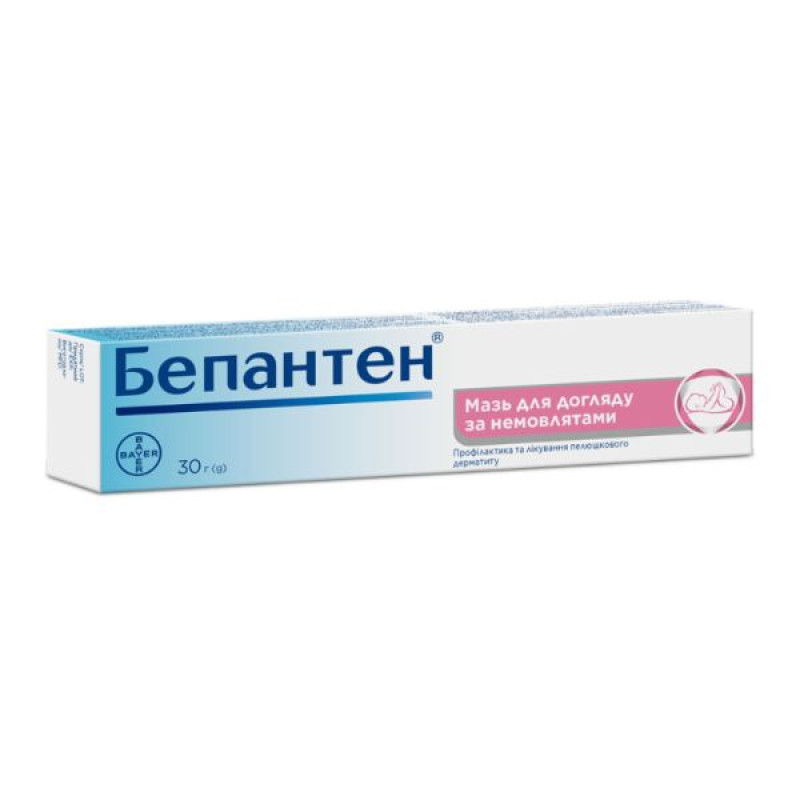Bepanten ointment 5% tube 30 g

Instructions Bepanten ointment 5% tube 30 g
Warehouse
active ingredient: 1 g of ointment contains dexpanthenol 50 mg;
excipients: cetyl alcohol, stearyl alcohol, white wax, lanolin, white soft paraffin, refined almond oil, mineral oil, protegin X (mineral oil, yellow soft paraffin, ozokerite, glycerol oleate, lanolin alcohol), purified water.
Dosage form
Ointment.
Main physicochemical properties: homogeneous ointment of white with a creamy tint, with a specific smell of lanolin.
Pharmacotherapeutic group
Drugs that promote wound healing (scarring).
ATX code D03A X03.
Pharmacological properties
Pharmacodynamics
Dexpanthenol, the active ingredient in Bepanthen® ointment, is rapidly converted into pantothenic acid in cells and acts as a vitamin. Dexpanthenol is more easily absorbed than pantothenic acid after topical application.
Pantothenic acid is a component of the essential coenzyme A (CoA). In this form of acetyl-coenzyme A, CoA plays a central role in the metabolism of every cell. Pantothenic acid is thus essential for the repair and regeneration of damaged skin and mucous membranes.
Pharmacokinetics
Dexpanthenol is quickly absorbed by the skin. After that, it is immediately converted into pantothenic acid and added to the internal depot of this vitamin.
In the blood, pantothenic acid binds to plasma proteins (mainly β-globulins and albumin). In healthy adult patients, the concentration is approximately 500-1000 μg/l and 100 μg/l in blood and serum, respectively.
Pantothenic acid is not metabolized in the body and is excreted unchanged. After oral administration, 60-70% of the dose is excreted in the urine, the rest in the feces. In adults, 2-7 mg of pantothenic acid is excreted in the urine per day, in children - 2-3 mg.
Indication
Bepanthen® ointment should be used in the following cases:
— to accelerate healing and epithelization of the skin in microinjuries (mild burns and scratches); in skin irritations (for example, due to radiotherapy, phototherapy or ultraviolet radiation); in chronic skin ulcers and bedsores; anal fissures; cervical erosions and after skin transplantation;
— for the prevention and treatment of cracked or rough and dry skin;
— for regular preventive care of the mammary glands in breastfeeding women and for the treatment of irritation and cracked nipples;
— for baby care: prevention and treatment of diaper dermatitis;
— for treating patients' skin during and after topical application of corticosteroids.
Contraindication
Hypersensitivity to dexpanthenol or to other components of the drug.
Interaction with other medicinal products and other types of interactions
There are no known cases of interactions with other drugs.
Application features
When using the drug, contact with eyes should be avoided.
Cetyl alcohol, stearyl alcohol, lanolin may cause local skin reactions (e.g. contact dermatitis).
The use of Bepanthen® ointment for healing and treating wounds in the genital or anus area while using latex condoms leads to a decrease in the strength and reliability of the condoms due to the excipient - white soft paraffin.
Use during pregnancy or breastfeeding
There is no reason to believe that the use of the drug during pregnancy or breastfeeding is risky. During pregnancy, the drug should be used as prescribed by a doctor.
When used to treat cracked nipples during breastfeeding, the product should be washed off before feeding.
Ability to influence reaction speed when driving vehicles or other mechanisms
Does not affect.
Method of administration and doses
Treatment of superficial wounds of any origin and prevention of cracked, dry or rough skin: apply Bepanthen® ointment 1 or more times a day as needed.
Breast care for breastfeeding women: apply ointment to nipples after each breastfeeding.
Treatment of cervical mucosal defects: apply the ointment 1 or more times a day under the supervision of a physician.
Baby care: apply Bepanthen® ointment after each diaper change.
Bepanthen® ointment, the active ingredient of which is dexpanthenol, has a base containing a large amount of fat. For use on weeping wounds, unprotected skin surfaces (face) and hairy skin, it is better to use Bepanthen® cream, which penetrates the skin quickly.
Children
The drug is used in children of different age groups, including infants.
Overdose
The active ingredient of Bepanthen® ointment, dexpanthenol, is well tolerated and is therefore considered non-toxic in the literature. Hypervitaminosis has not been described.
Adverse reactions
Immune system and skin and subcutaneous tissue disorders: Allergic reactions and allergic skin reactions have been reported: contact dermatitis, allergic dermatitis, pruritus, erythema, eczema, rash, urticaria, skin irritation and blisters.
Expiration date
3 years.
Storage conditions
Store below 25°C. Keep out of the reach of children.
Packaging
3.5 g, or 30 g or 100 g in a tube. 1 tube in a cardboard box.
Vacation category
Without a prescription.
Producer
GP Grenzach Produktions GmbH, Germany.
Location of the manufacturer and its business address.
Emil-Barell-Strasse 7, 79639 Grenzach-Wyhlen, Germany.
Applicant
Bayer Consumer Care AG, Switzerland/Bayer Сonsumer Care AG, Switzerland
Applicant's location
Peter Merian-Strasse 84, 4052 Basel, Switzerland.
There are no reviews for this product.
There are no reviews for this product, be the first to leave your review.
No questions about this product, be the first and ask your question.

















